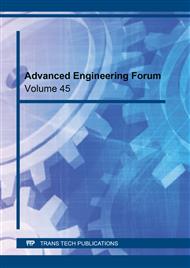[1]
Bogdański, S., Lewicki, P. and Szymaniak, M. Experimental and theoretical investigation of the phenomenon of filling the RCF crack with liquid. Wear, 258(7-8), (2005) pp.1280-1287.
DOI: 10.1016/j.wear.2004.03.038
Google Scholar
[2]
Bogdański, S., and P. Lewicki. 3D model of liquid entrapment mechanism for rolling contact fatigue cracks in rails. Wear 265, no. 9-10 (2008) 1356-1362.
DOI: 10.1016/j.wear.2008.03.014
Google Scholar
[3]
Farjoo, Mohammadali, Sarvesh Pal, William Daniel, and Paul A. Meehan. Stress intensity factors around a 3D squat form crack and prediction of crack growth direction considering water entrapment and elastic foundation. Engineering Fracture Mechanics 94 (2012) 37-55.
DOI: 10.1016/j.engfracmech.2012.07.011
Google Scholar
[4]
Fletcher, D. I., P. Hyde, and A. Kapoor. Modelling and full-scale trials to investigate fluid pressurisation of rolling contact fatigue cracks. Wear 265, no. 9-10 (2008) 1317-1324.
DOI: 10.1016/j.wear.2008.02.025
Google Scholar
[5]
Fletcher, D. I., L. Smith, and A. Kapoor. Rail rolling contact fatigue dependence on friction, predicted using fracture mechanics with a three-dimensional boundary element model. Engineering Fracture Mechanics 76, no. 17 (2009) 2612-2625.
DOI: 10.1016/j.engfracmech.2009.02.019
Google Scholar
[6]
Farjoo, Mohammadali, William Daniel, and Paul A. Meehan. Modelling a squat form crack on a rail laid on an elastic foundation. Engineering Fracture Mechanics 85 (2012) 47-58.
DOI: 10.1016/j.engfracmech.2012.02.004
Google Scholar
[7]
Seo, Jungwon, Seokjin Kwon, Hynukyu Jun, and Donghyeong Lee. Fatigue crack growth behavior of surface crack in rails. Procedia Engineering 2, no. 1 (2010) 865-872.
DOI: 10.1016/j.proeng.2010.03.093
Google Scholar
[8]
Dubourg, M. C., and V. Lamacq. A predictive rolling contact fatigue crack growth model: onset of branching, direction, and growth-role of dry and lubricated conditions on crack patterns. J. Trib. 124, no. 4 (2002) 680-688.
DOI: 10.1115/1.1479698
Google Scholar
[9]
Brouzoulis, Jim, and Magnus Ekh. Crack propagation in rails under rolling contact fatigue loading conditions based on material forces. International Journal of Fatigue 45 (2012) 98-105.
DOI: 10.1016/j.ijfatigue.2012.06.002
Google Scholar
[10]
Ringsberg, Jonas W., and Torbjörn Lindbäck. Rolling contact fatigue analysis of rails inculding numerical simulations of the rail manufacturing process and repeated wheel-rail contact loads. International Journal of fatigue 25, no. 6 (2003) 547-558.
DOI: 10.1016/s0142-1123(02)00147-0
Google Scholar
[11]
A. Kapoor, D. I. Fletcher , Newrail Report NO. WR061106-2, Newcastle University. (2006).
Google Scholar
[12]
A. Kapoor, D. I. Fletcher, Tech. rep., Newrail Report NO. WR061106-3,Newcastle University. (2006).
Google Scholar
[13]
A. Kapoor, D. I. Fletcher, Newrail Report NO. WR061106-4. Newcastle University. (2006).
Google Scholar
[14]
A. Kapoor, D. I. Fletcher, F. J. Franklin, L. .Smith, P. Hyde, Tech. rep., Newrail Report NO. WR061106-6. Newcastle University, (2006).
Google Scholar
[15]
Seo, Jung Won, Byeong Choon Goo, Jae Boong Choi, and Young Jin Kim. Effects of metal removal and residual stress on the contact fatigue life of railway wheels. International Journal of Fatigue 30, no. 10-11 (2008) 2021-2029.
DOI: 10.1016/j.ijfatigue.2007.12.003
Google Scholar
[16]
Bogdański, Stanisław, and Michael W. Brown. Modelling the three-dimensional behaviour of shallow rolling contact fatigue cracks in rails. Wear 253, no. 1-2 (2002) 17-25.
DOI: 10.1016/s0043-1648(02)00078-9
Google Scholar
[17]
Abaqus 6.12, Dassault System Center of Simulation Excellence, Theory Manual, (1998).
Google Scholar
[18]
Maya-Johnson, S., A. J. Ramirez, and A. Toro. Fatigue crack growth rate of two pearlitic rail steels. Engineering fracture mechanics 138 (2015) 63-72.
DOI: 10.1016/j.engfracmech.2015.03.023
Google Scholar
[19]
Zhao, Xin, Xiaogang Zhao, Chao Liu, Zefeng Wen, and Xuesong Jin. A study on dynamic stress intensity factors of rail cracks at high speeds by a 3D explicit finite element model of rolling contact. Wear 366 (2016) 60-70.
DOI: 10.1016/j.wear.2016.06.001
Google Scholar
[20]
Masoudi Nejad, Reza, Khalil Farhangdoost, Mahmoud Shariati, and Majid Moavenian. Stress intensity factors evaluation for rolling contact fatigue cracks in rails. Tribology Transactions 60, no. 4 (2017) 645-652.
DOI: 10.1080/10402004.2016.1197351
Google Scholar
[21]
Pang, John HL, Kin Shun Tsang, and Hsin Jen Hoh. 3D stress intensity factors for weld toe semi-elliptical surface cracks using XFEM. Marine Structures 48 (2016) 1-14.
DOI: 10.1016/j.marstruc.2016.04.001
Google Scholar
[22]
ASTM International, E399-17. Standard test method for linear-elastic plane-strain fracture toughness Kic of metallic materials, (2017).
DOI: 10.1520/e0399-12e02
Google Scholar
[23]
ASTM International, ASTM E647 - 15e1 standard test method for measurement of fatigue crack growth rates, (2015).
Google Scholar
[24]
Motameni Tabatabaei, Ali. Fracture and fatigue crack growth characterization of conventional and head hardened railway rail steels. Master's thesis, Middle East Technical University, (2014).
Google Scholar
[25]
Powell, A. F., and P. J. Gräbe. Exploring the relationship between vertical and lateral forces, speed and superelevation in railway curves. Journal of the South African Institution of Civil Engineering 59, no. 3 (2017) 25-35.
DOI: 10.17159/2309-8775/2017/v59n3a4
Google Scholar
[26]
The British Standards, BS EN 14730-1-2017 Railway application-Track-Alumino thermic welding of rails, (2017).
Google Scholar
[27]
Liu, Yang, Kin Shun Tsang, Hsin Jen Hoh, Xiaopeng Shi, and John Hock Lye Pang. Structural fatigue investigation of transverse surface crack growth in rail steels and thermite welds subjected to in-plane and out-of-plane loading. Engineering Structures 204 (2020) 110076.
DOI: 10.1016/j.engstruct.2019.110076
Google Scholar
[28]
Information on https://web.mit.edu/course/3/3.11/www/modules/frac.pdf.
Google Scholar
[29]
Paris, Paul, and Fazil Erdogan. A critical analysis of crack propagation laws.(1963) 528-533.
Google Scholar
[30]
Information on https://web.mit.edu/course/3/3.11/www/modules/frac.pdf.
Google Scholar
[31]
IACS, Requirements Concerning Materials and Welding, International Association of Classification Societies, (2016).
Google Scholar
[32]
Zerbst, Uwe, Roger Lundén, K-O. Edel, and Roderick A. Smith. Introduction to the damage tolerance behaviour of railway rails–a review. Engineering fracture mechanics 76, no. 17 (2009) 2563-2601.
DOI: 10.1016/j.engfracmech.2009.09.003
Google Scholar
[33]
Kalker, J. J. Wheel-rail rolling contact theory. Wear 144, no. 1-2 (1991) 243-261.
DOI: 10.1016/0043-1648(91)90018-p
Google Scholar
[34]
Massarelli, Peter JohnPaul. Fatigue reliability of steel highway bridge details. University of Virginia, (1997).
Google Scholar
[35]
Pierres, Emilien, Marie-Christine Baietto, and Anthony Gravouil. Experimental and numerical analysis of fretting crack formation based on 3D X-FEM frictional contact fatigue crack model. Mechanical Reports 339, no. 7-8 (2011) 532-551.
DOI: 10.1016/j.crme.2011.05.011
Google Scholar
[36]
Paris, Paul, and Fazil Erdogan. A critical analysis of crack propagation laws. (1963) 528-533.
Google Scholar
[37]
Chandra, S., Agarwal, M.M., Railway Engineering. Oxford University Press, Third Impression, (2009).
Google Scholar


